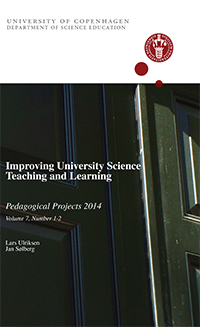Evaluating the use of a student response system in high enrollment anatomy lectures
Nøgleord:
evaluating, response systems, high enrollment, anatomy lectures, SRS, feedback, software, questionnaireResumé
Student response systems1 (SRS) are devices or software that allow students to provide responses to questions embedded within a lecture, which can then be automatically summarized to provide immediate feedback to the students and/or teachers (Wieman 2008, Mathiasen 2013, Vicens 2013). I recently used an SRS, Shakespeak®, for my lectures in Anatomy in the course Exercise Physiology 1 at the Department of Nutrition, Exercise and Sports, University of Copenhagen. Anatomy lectures are often thought to be dull and full of details and difficult names, and with 136 students in the course it can be challenging to engage and interact with the students. The aim of this project was to evaluate the use of Shakespeak® based on student feedback from a questionnaire and a focus group interview. Questionnaire results showed that 99% of respondent liked the quizzes, while 88% thought that they helped them to remember the content of the lectures. About 55% believed that the quizzes influenced how they studied after a lecture and 72% felt better prepared for the exam. Qualitative analyses of the students’ open-ended responses in the questionnaire and comments from the focus group interview provided support and additional insights for the quantitative analyses. Overall, the Shakespeak® quizzes were popular with the students, and
they made the course more engaging and motivating. The quizzes helped 100 Svend Sparre Geertsen the students to retain information and prepare them for the exam, and the students wished that they would also be used in courses other than just
Anatomy.
Downloads
Publiceret
Citation/Eksport
Nummer
Sektion
Licens
Fra og med årgang 19 (2023) er artikler udgivet i IUSTL udgivet med Creative Commons Navngivelse –Ikke-kommerciel (by-nc) licens. Redaktionen kan godkende andre Creative Commons Licencer for enkelte artikler, hvis forfatteren har anmodet om det.
Artikler i årgangene 1-18 er ikke udgivet under Creative Commons licens. I disse udgivelser tilfalder alle rettigheder forfatteren. Det betyder, at læsere kan downloade, læse og linke til artiklerne, men de kan ikke genudgive artiklerne. Forfatterne kan uploade deres artikler i et institutionsrepositiry som led i en grøn open access politik.




